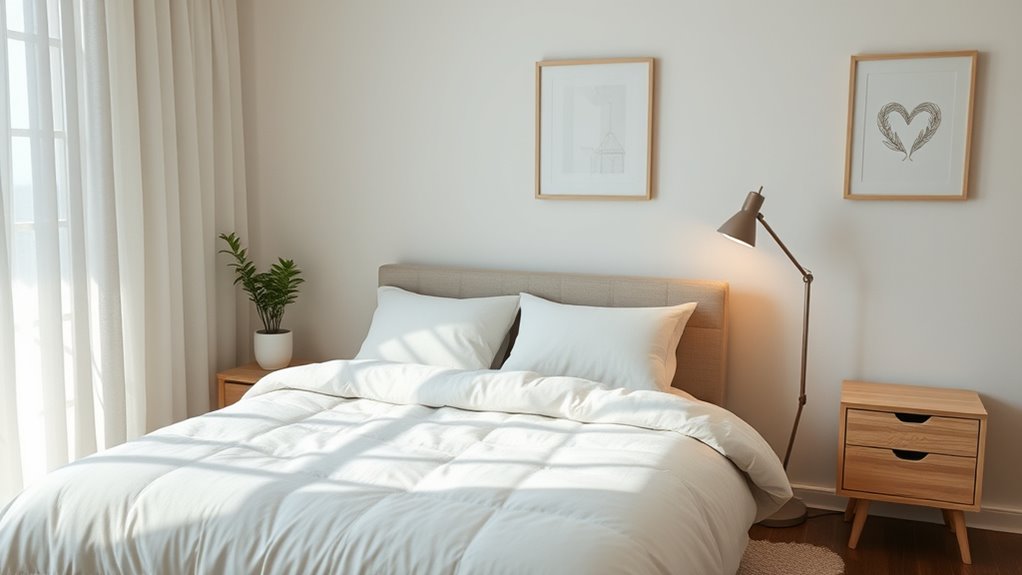To design a calm bedroom for restful sleep, choose soothing colors like soft blues, greens, and neutrals that promote relaxation. Use gentle lighting with dimmers or warm bulbs, and keep the space clutter-free with thoughtful furniture placement. Incorporate soft textures with plush bedding and natural materials, and create a tech-free zone by removing screens before bed. Adding personal touches and maintaining a consistent environment helps you unwind effortlessly—discover more tips to transform your space into a peaceful retreat.
Key Takeaways
- Use soft, muted colors and natural materials to create a serene, calming atmosphere.
- Arrange furniture thoughtfully, emphasizing a central bed and uncluttered nightstands for a peaceful layout.
- Incorporate adjustable, warm lighting and eliminate harsh or bright lights before bedtime.
- Add plush textiles, layered textures, and natural elements like plants or water features for tactile comfort.
- Maintain a clutter-free, tech-free zone with a consistent sleep routine and optimal environment conditions.
Choosing Soothing Color Palettes
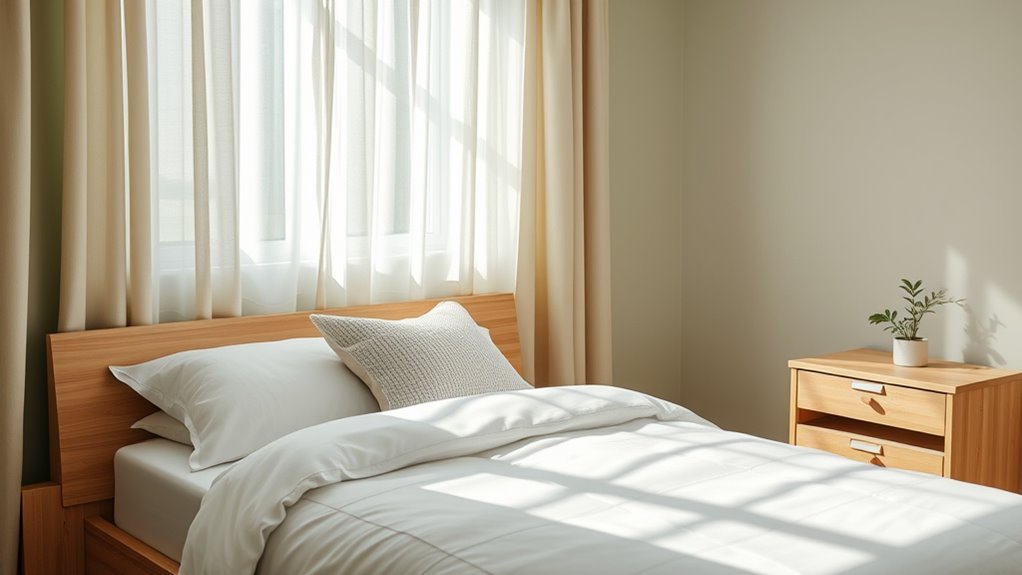
Selecting the right color palette is essential for creating a calming bedroom environment. Color psychology plays a key role in influencing your mood, so choosing soothing hues can considerably enhance your sense of relaxation. Soft, muted tones like gentle blues, calming greens, and warm neutrals promote tranquility and help reduce stress. These colors foster a peaceful atmosphere, making it easier to unwind after a long day. When you select calming shades, you’re actively supporting mood enhancement and creating a space that invites rest. Avoid overly bright or bold colors, which can stimulate the mind and disrupt relaxation. Instead, focus on harmonious, understated palettes that promote serenity and comfort, setting the perfect foundation for a restful night’s sleep. Incorporating elements of dynamic communication exercises for couples can also improve your overall well-being and mental clarity, further enhancing your sleep environment.
Optimizing Lighting for Relaxation
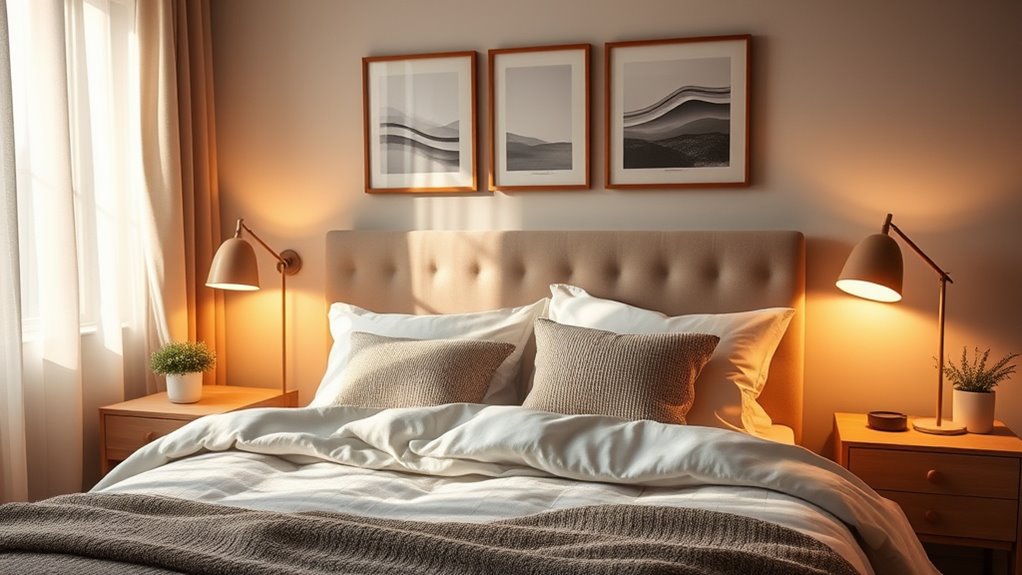
To create a truly relaxing bedroom, optimizing your lighting is essential because the right illumination can considerably influence your mood and sleep quality. Smart lighting allows you to customize brightness and color temperature, creating a calming environment in the evening. Use adjustable fixtures, such as dimmer switches or bedside lamps, to control light levels easily. Soft, warm lights promote relaxation and signal your body that it’s time to wind down. Avoid harsh, bright lighting before bed, which can interfere with melatonin production. Instead, opt for layered lighting that can be dimmed or warmed up as needed. Incorporating lighting control features can further enhance your ability to create the perfect sleep environment. By integrating smart lighting and adjustable fixtures, you create a flexible, soothing atmosphere that supports restful sleep and enhances your bedroom’s tranquility.
Decluttering to Create a Peaceful Space
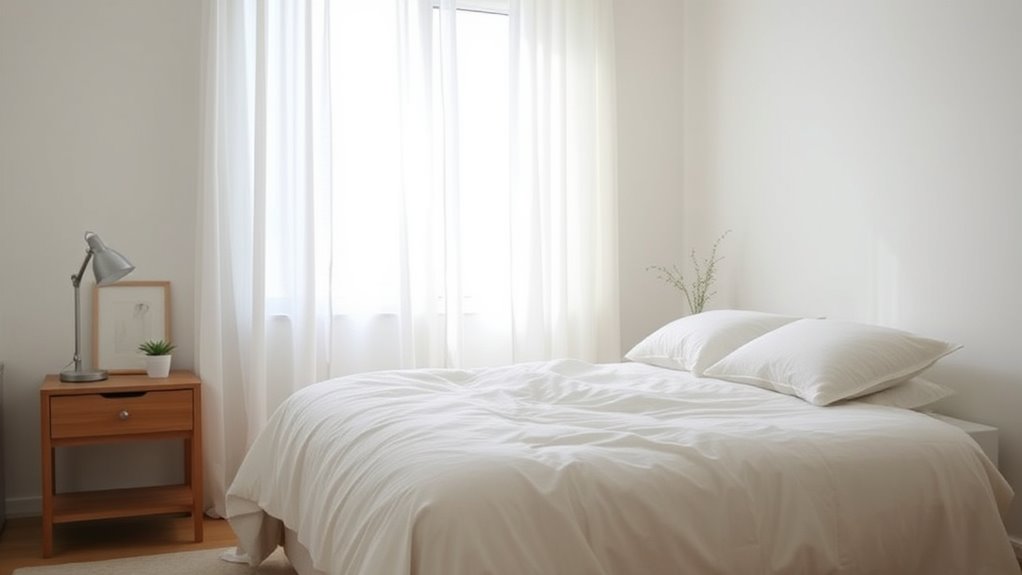
A cluttered space can quickly disrupt the sense of calm you want to cultivate in your bedroom. To create a peaceful environment, start by organizing your nightstands, keeping only essentials like a lamp, book, or glass of water. Clear surface clutter to promote relaxation. Next, remove clutter from closets, folding or donating items you no longer need. A tidy closet reduces visual chaos and makes it easier to find what you want, preventing stress. Regularly declutter your space, setting aside time each week to tidy up. This effort helps maintain a serene atmosphere, making your bedroom a true retreat. Incorporating clutter management techniques can further enhance the sense of calm in your space. Remember, a clean and organized room supports restful sleep and a calm mind.
Incorporating Soft Textures and Fabrics
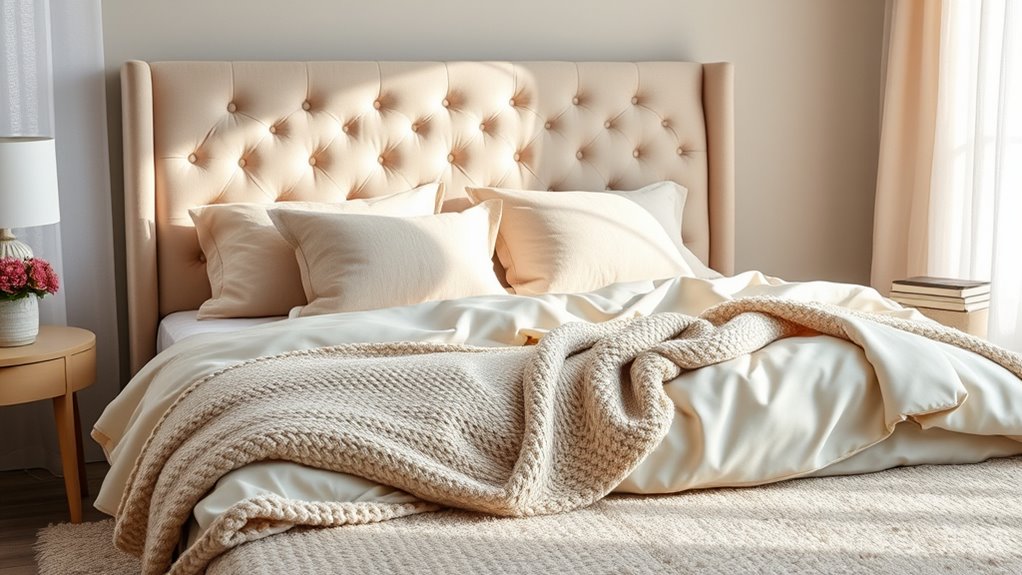
Adding plush bedding and soft fabrics instantly makes your bedroom feel more inviting and calming. Layering different textures creates depth and comfort, making the space more soothing. Focus on combining materials that feel gentle against your skin to enhance the overall tranquility. Incorporating reliable safety features such as non-slip fabrics and flame-retardant textiles can also contribute to a safer, more secure environment for restful sleep.
Plush Bedding Choices
Choosing plush bedding transforms your bedroom into a sanctuary of softness and comfort. Opt for luxurious linens that feel silky against your skin, creating a calming atmosphere. Cozy comforters in plush fabrics add a layer of warmth without feeling heavy, enhancing your sense of relaxation. Look for high-thread-count sheets and smooth duvet covers that invite you to sink in effortlessly. The tactile quality of plush bedding helps signal to your brain that it’s time to unwind and rest. By selecting soft, inviting textures, you create a restful environment that promotes better sleep. Keep your bedding simple and cohesive, focusing on quality over quantity, so your space remains calm and clutter-free. Plush bedding becomes the perfect foundation for a peaceful, sleep-ready bedroom. Incorporating soft textures and fabrics can further enhance the calming effect and encourage restful sleep.
Layered Textural Elements
Incorporating layered textures and soft fabrics elevates the sense of comfort in your bedroom, making it feel inviting and soothing. Layered textural elements add depth and visual interest, creating a tactile comfort that calms your mind. Use a variety of fabrics, such as plush throws, textured pillows, and cozy rugs, to break up smooth surfaces and introduce subtle variations. Mixing different materials like linen, velvet, and knits enhances the sensory experience, making your space feel more inviting. These tactile details encourage relaxation and help you unwind after a long day. Keep the color palette soft and neutral to maintain a calm atmosphere while ensuring the textures work harmoniously together for a peaceful retreat. For a truly soothing environment, consider incorporating best-rated textiles known for their softness and durability, which can significantly enhance your bedroom’s comfort.
Selecting Comfortable and Supportive Bedding
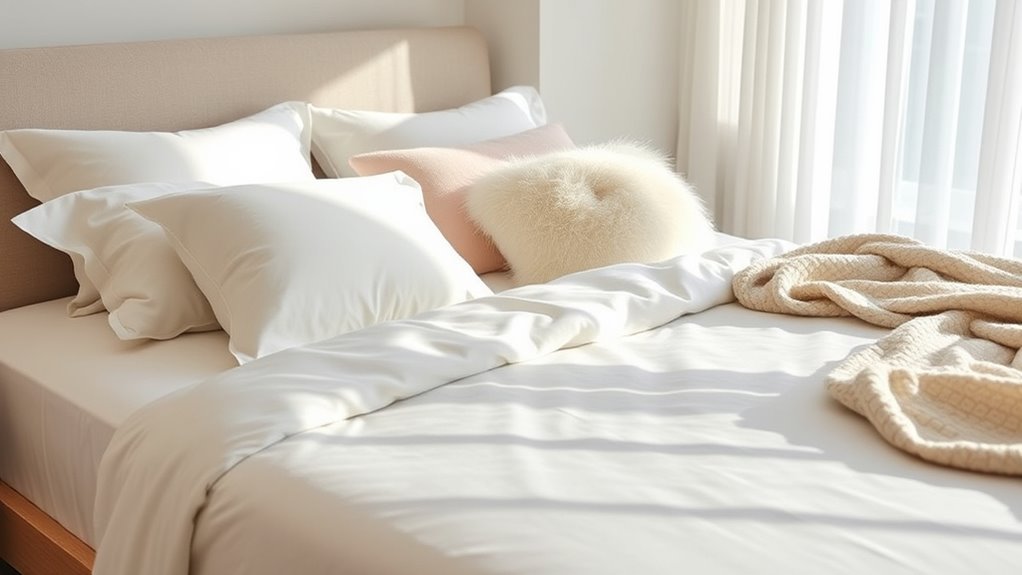
Choosing the right bedding starts with selecting materials that feel comfortable against your skin. Supportive sleep essentials, like a good mattress and pillows, are key to waking up refreshed. When you prioritize quality and comfort, your bedroom becomes a true sanctuary for restful nights. Additionally, being aware of emotional motivations related to sleep comfort can help you tailor your bedding choices to better meet your needs.
Material Matters for Comfort
Have you ever wondered how the right bedding can transform your sleep experience? Choosing eco-friendly materials like organic cotton or bamboo guarantees you’re resting comfortably while supporting sustainability. Comfort also depends on ergonomic furniture that promotes proper posture and reduces tension. Imagine a cozy bed with soft, breathable sheets paired with supportive bedding that keeps you aligned. Here’s a visual to help you picture it:
| Material Type | Comfort Benefits |
|---|---|
| Organic Cotton | Soft, breathable, eco-friendly |
| Bamboo | Smooth, moisture-wicking |
| Ergonomic Mattress | Supports spinal alignment |
Selecting the right combination creates a calming environment, letting your body relax fully for restful sleep. Incorporating air purifiers into your bedroom can further enhance air quality, creating a healthier sleep environment.
Supportive Sleep Essentials
A well-supported sleep setup starts with bedding that balances comfort and stability. Your mattress type plays an essential role; options like memory foam, latex, or innerspring each offer different support levels. Choose a mattress that aligns with your preferred sleeping position and provides adequate spinal alignment. Alongside your mattress, pillow firmness impacts sleep quality. If you sleep on your side, a softer pillow can cushion your neck, while back and stomach sleepers benefit from firmer support to prevent strain. Make certain your pillow maintains proper head and neck alignment. Combining the right mattress type with the appropriate pillow firmness creates a supportive environment, reducing discomfort and promoting restful sleep. Prioritizing these essentials helps you wake up feeling refreshed and ready for the day. Attention in creative practice can also enhance your focus on sleep environments, leading to better nightly rest.
Using Natural Elements to Foster Calm

Incorporating natural elements into your bedroom creates an immediate sense of tranquility. You can achieve this by adding indoor water features, which bring soothing sounds and a calming atmosphere. Natural light enhancement is also essential; maximize sunlight during the day with sheer curtains or strategically placed mirrors to brighten your space. To further foster calm, consider these options:
- Use plants to improve air quality and add a touch of greenery.
- Incorporate natural materials like wood, stone, or bamboo in furniture and decor.
- Include calming colors inspired by nature, such as soft greens, blues, or earth tones.
- Optimizing your workspace within the bedroom can reduce stress and improve overall relaxation removing clutter.
These elements help create a peaceful environment, making your bedroom a sanctuary for restful sleep.
Creating a Technology-Free Zone
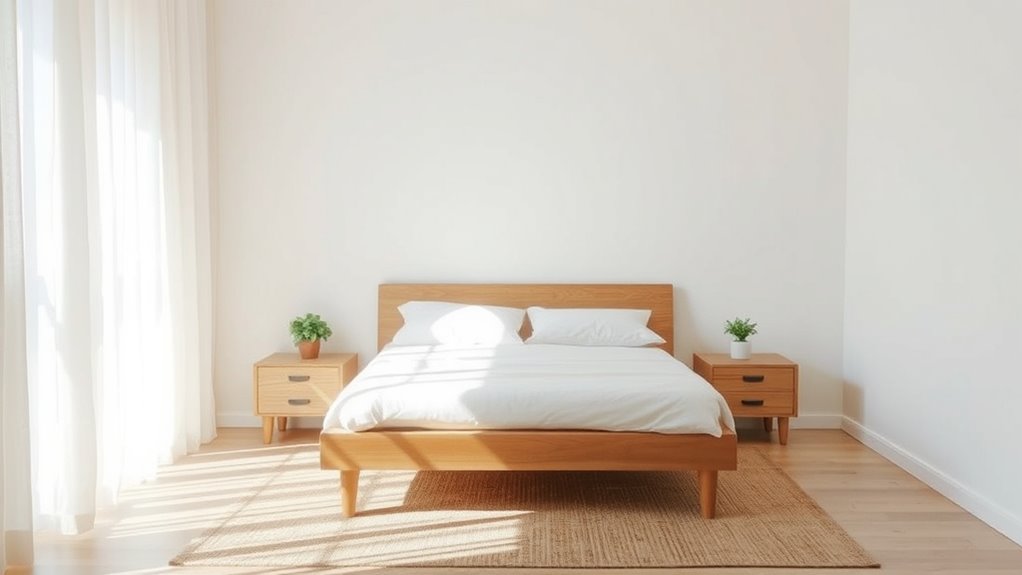
To create a calming bedroom, start by limiting your screen time before bed to reduce distractions and stress. Set up a designated charging station outside the bedroom to keep devices out of sight and mind. This simple change can make your space feel more peaceful and help you unwind fully.
Limit Screen Usage
Creating a technology-free zone in your bedroom can considerably improve your sleep quality and overall relaxation. Limiting screen usage helps you unwind and reduces eye strain caused by prolonged digital exposure. To achieve this, consider these steps:
- Set a digital detox hour: Turn off devices at least 30 minutes before bed to signal your mind it’s time to relax.
- Remove screens from the bedroom: Keep smartphones, tablets, and laptops out of your sleeping area to minimize temptation.
- Use alternative calming activities: Read a book, meditate, or listen to soothing music to wind down without screens.
Establish Charging Stations
Establishing dedicated charging stations in your bedroom helps keep devices organized and out of sight, reducing the temptation to use them before bed. Choose a specific spot near your bed where you can set up multiple charging stations, making sure there are enough power outlets to accommodate all your devices. Using a power strip with surge protection guarantees safety and easy access. Keep cords neatly organized with clips or cable sleeves to prevent clutter. When your devices are stored in their designated charging stations, you’re less likely to reach for them late at night or first thing in the morning. This simple setup creates a calmer environment, encouraging you to disconnect and focus on restful sleep instead of screen time.
Arranging Furniture for Tranquility
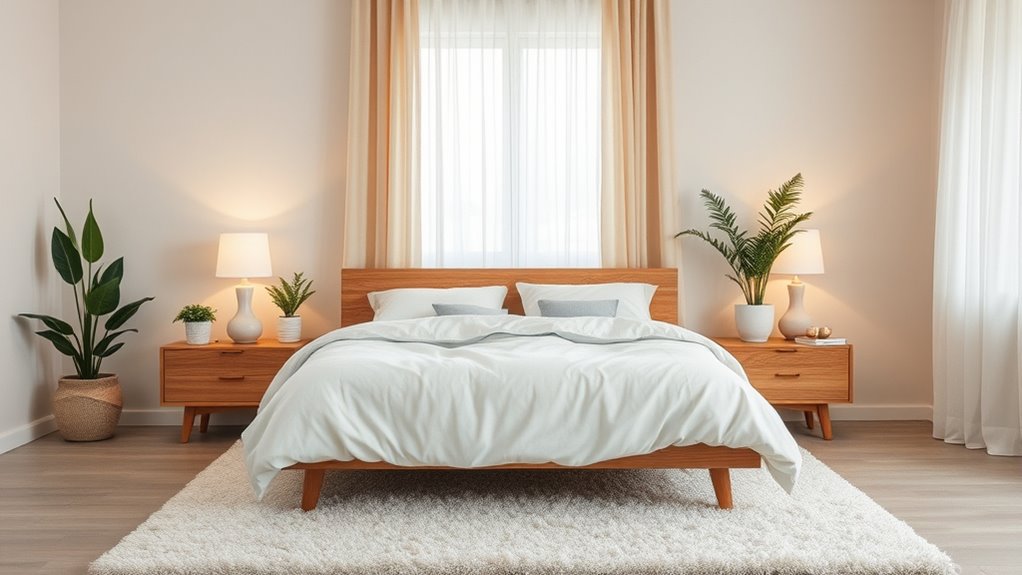
Arranging furniture thoughtfully can considerably enhance the sense of calm in your bedroom. Focus on creating artful furniture arrangements that promote a peaceful environment. Prioritize balanced layouts by keeping the bed as the focal point and leaving ample space around it. To achieve this, consider these steps:
- Place the bed centrally, avoiding clutter on either side.
- Keep nightstands simple and uncluttered to foster a serene atmosphere.
- Arrange other furniture to maintain open pathways, preventing a cramped feel.
Adding Personal Touches That Promote Comfort
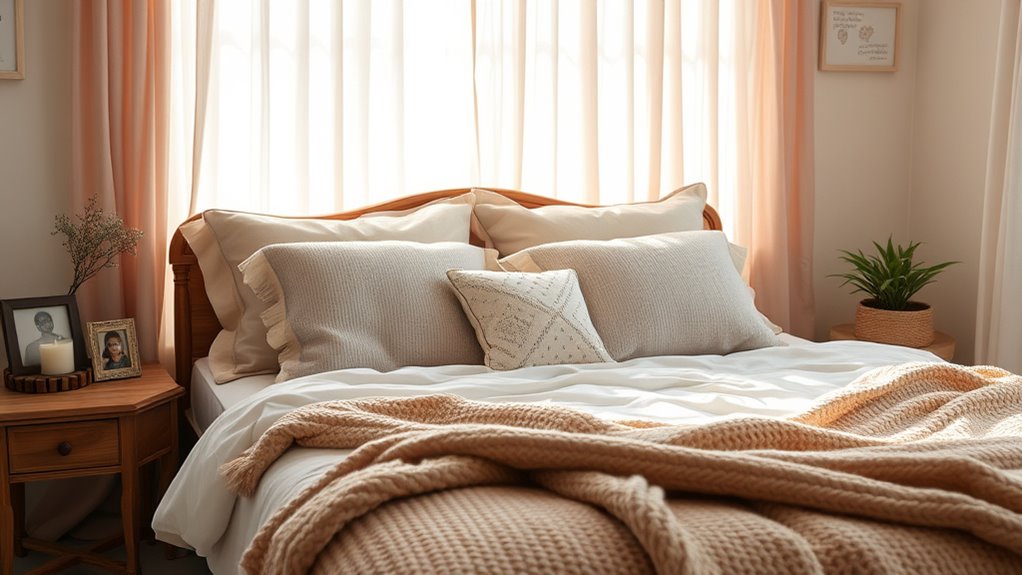
Adding personal touches to your bedroom can considerably boost comfort and make the space feel more inviting. Incorporate personal mementos like photos, souvenirs, or heirlooms that bring you joy and create a sense of familiarity. Use decorative accents, such as cozy throw pillows, soft rugs, or calming artwork, to add personality without cluttering the space. These elements help turn a plain room into a sanctuary that reflects your style and makes you feel relaxed. Keep the arrangement simple and intentional, avoiding excess clutter that can disrupt tranquility. By thoughtfully selecting meaningful objects and understated decorative accents, you’ll foster a calming environment that promotes restful sleep and overall comfort.
Maintaining a Consistent Sleep Environment
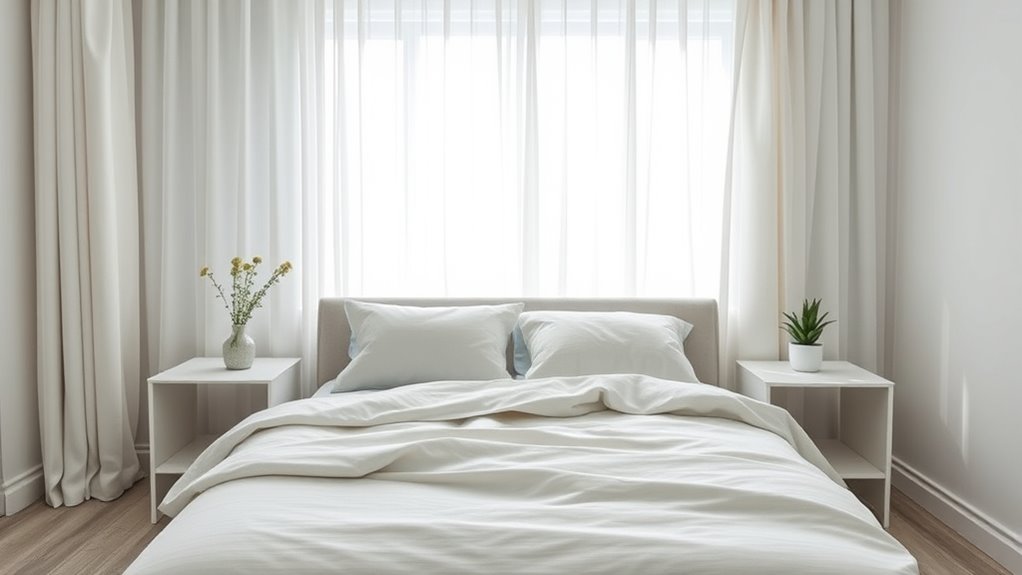
Maintaining a consistent sleep environment is essential for ensuring restful nights and waking up refreshed. To achieve this, focus on controlling key factors. First, adjust the thermostat so your bedroom stays within a comfortable range, ideally between 60-67°F. Second, keep noise levels low by using earplugs or white noise machines to block disruptive sounds. Third, stick to a regular sleep schedule, going to bed and waking up at the same times each day. Consistency in these areas helps your body establish a stable routine, making it easier to fall asleep and stay asleep. By maintaining a steady environment, you signal your body that it’s time to rest, leading to more restorative sleep each night.
Frequently Asked Questions
How Can I Reduce Noise in My Bedroom for Better Sleep?
To reduce noise in your bedroom for better sleep, start by installing soundproof curtains that block out external sounds. Add acoustic panels to walls to absorb noise and prevent echoing. You can also seal gaps around windows and doors with weatherstripping to minimize sound leaks. Using a white noise machine can further mask persistent sounds, creating a peaceful environment that promotes restful sleep.
What Are the Best Window Treatments to Block Out Light?
Your sleep depends on total darkness, and blackout curtains are your best bet—they block out nearly all light. For an extra layer of darkness, consider window shutters, which can seal off sunlight completely. These treatments work together like a fortress against light intrusion, ensuring your bedroom stays pitch-black. Installing blackout curtains and shutters creates a sleep sanctuary, turning even the brightest mornings into a restful, uninterrupted night.
How Do I Choose Eco-Friendly Bedroom Decor?
You should choose eco-friendly bedroom decor by prioritizing items made from eco-friendly materials like organic cotton, bamboo, or reclaimed wood. Look for products with sustainable sourcing certifications, ensuring they’re responsibly harvested and produced. Opt for furniture and accessories that emphasize durability and minimal environmental impact. By selecting sustainable materials and verifying their sourcing, you create a calming, environmentally conscious space that supports both your well-being and the planet.
What Are Some Budget-Friendly Ways to Create a Calming Bedroom?
A penny saved is a penny earned, so start with budget-friendly DIY decor to create a calming atmosphere. Focus on simple color schemes like soft blues or neutral tones to promote relaxation. You can repurpose items you already own or craft your own decorations for a personal touch. Small changes, like adding cozy textiles or rearranging furniture, make a big difference without breaking the bank.
How Often Should I Clean or Replace My Bedding for Optimal Sleep?
You should clean your bedding at least once a week to maintain ideal sleep and control allergens. Replace your pillows every 1-2 years and your mattress every 7-10 years for better bedding maintenance. Regular washing reduces dust mites and allergens, creating a calmer sleeping environment. Keep your sheets, pillowcases, and comforters fresh to guarantee restful sleep and minimize allergy triggers, helping you wake up feeling refreshed every morning.
Conclusion
So, after all your efforts to craft the perfect tranquil retreat, don’t forget the irony: sometimes, the most restful sleep comes from simply embracing imperfection. A cluttered corner or a flickering light might be just what reminds you that serenity isn’t about perfection, but about acceptance. So, go ahead—create your peaceful sanctuary, and then let go of the need for it to be perfect. After all, true calm is often found in letting go.
